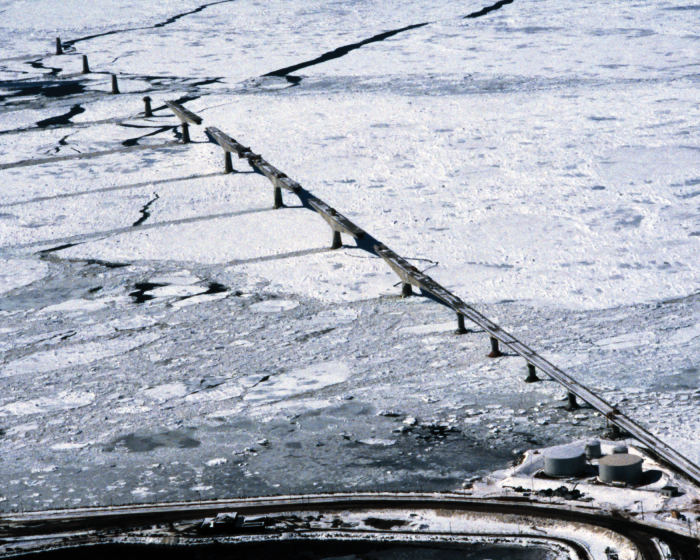


コンフェデレーション橋は、海水上に建設された世界最長の連続プレストレストコンクリート箱桁橋の 1 つであり、氷に覆われた海上に建設された橋としては最長のスパンです。カナダのプリンスエドワード島のボーデンからニューブランズウィック州のケープ トルメンタインまで 13 km にわたっています。コンフェデレーション橋の建設は畏敬の念を抱かせる出来事でした。現在も継続中の長期にわたる監視および研究プロジェクトにより、この橋は工学上の驚異としてさらに高い評価を受けています。
ノーサンバーランド海峡の厳しい環境に耐えられるように建設されたコンフェデレーション橋は、100 年の耐用年数を実現するように設計されました。橋の短期および長期の性能をより深く理解するために、建設中に複数年にわたる監視および研究プロジェクトが立ち上げられました。この研究は、将来の長スパン橋の荷重モデルの開発に貢献します。
計装
監視機器には、橋の建設中に設置されたものもあり、500 台以上のひずみ測定装置、450 個の温度センサー、28 個の氷荷重パネル、12 個の傾斜計、76 個の振動センサー、水中ソナー装置などが含まれています。6 台の Campbell Scientific CR9000 測定および制御システムが、機器の中心にあります。これらの高速データ収集システムは、光ファイバーを介してコンピューターに接続されています。CR9000 は、1998 年以来、連続的に高速測定を行っています。氷の衝撃、地震活動、交通量の増加、または強風によって事前に設定されたトリガー振幅が検出されると、すべてのロガーがトリガーされ、トリガー前とトリガー後のデータが保存されます。収集されたデータは、さらに分析するために、オタワのカールトン大学とカルガリー大学の研究者に送信されます。
特に興味深いのは、以下で説明する監視および研究の領域です。
氷の流れ
氷と橋脚の相互作用は、橋脚の氷シールドに設置された 28 枚の氷荷重パネルを使用して監視および分析されます。各氷パネルは、ロード セルとして機能する 8 つの衝撃ゾーンに分割されています。各ゾーンのひずみゲージは、「ホイートストン ブリッジ」信号を生成します。
224 個の差動信号はシングルエンド信号に変換され、約 5 Hz に帯域制限された後、増幅およびフィルタリングされた信号が 2 つの CR9000 に送信されます。
氷の流れと尾根の衝撃、これらの衝撃によって生じる力、および橋の反応が測定されます。長期データは、氷の力をよりよく理解するために使用されます。
短期的および長期的な変形
橋梁コンクリートの変化、基礎の変位、プレストレスト鋼鉄筋の張力低下により、時間の経過とともに橋梁構造に変形が生じる可能性があります。これらの変形は、実験室および現場でのテストを使用して監視され、20 年間にわたる鋼鉄の弛緩とコンクリートのクリープおよび収縮が判定されます。
熱応力
センサーは、日々および季節的な温度変化 (熱ストレス) に対する橋の反応を記録します。建設中および建設後に実施される監視には、実験室でのテスト、コンクリートの熱特性のシミュレーション、およびコンピュータ モデルの調整が含まれます。
交通負荷と負荷の組み合わせ
センサー測定のデータはデータベースに保存されています。このデータベースは、将来の傾向を判断するために使用されます。橋の設計に重大な荷重効果をもたらす荷重組み合わせ技術について研究が行われます。その結果は、長スパン橋の荷重モデルや将来の運用戦略の開発に役立ちます。コンフェデレーション橋の監視が始まる前は、そのようなモデルは存在しませんでした。
振動
風、交通、氷の衝撃、地震などにより、橋は振動します。振動を測定するために、橋の 1 km 区間にわたって 75 個の加速度計が配置されています。加速度計の信号はフィルタリングされ、同じ区間に沿って配置されたデータロガーに送信されます。振動を監視することで、振動応答や地震による地盤運動の空間的変化の影響を判断するためのコンピューター モデリングおよび分析技術の開発に役立ちます。これにより、構造力学、特に長スパン構造物の耐震および耐風設計工学に関する知識が深まります。
ケーススタディの概要
アプリケーション
世界最長の連続プレストレストコンクリート箱桁橋の1つにおける氷の影響、熱応力、荷重、短期および長期の変形、振動の監視場所
コンフェデレーション橋、プリンスエドワード島、ノバスコシア州、カナダ使用製品
CR9000X寄稿者
Mike Montreuil, National Research Council; John Halloran, Campbell Scientific, Inc.参加団体
政府、産業界、学術機関のコンソーシアム計測項目
歪み、温度、振動、傾き関連ウェブサイト
Confederation BridgePDFで見る